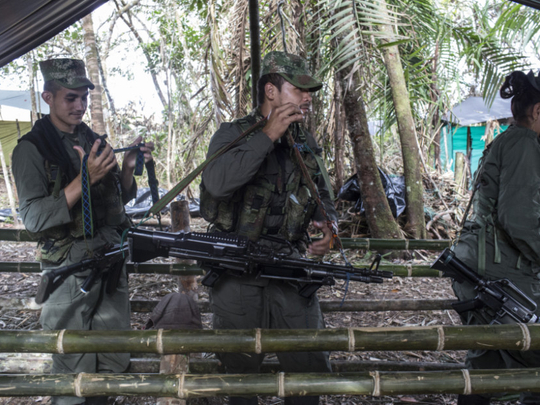
Tomorrow, Colombians will decide whether to ratify a peace deal that makes the Revolutionary Armed Forces of Colombia (Farc) lay down their arms. But if that happens, what will the future of Farc look like? Will it become a socialist party, like the one that has driven Venezuela into an economic crisis?
It’s a frightening prospect if Farc’s top leader, Rodrigo “Timochenko” Londono, dons the presidential sash. It conjures up images of thousands of Colombians queuing, like their Venezuelan neighbours right now, for eggs, bread and toilet paper while newborns are placed in cardboard boxes because of a dearth of hospital beds. Are Colombians about to dig their own graves by voting to approve the peace deal?
In 1998, Hugo Chavez won Venezuela’s presidential elections with 56 per cent of the vote, breaking up the two-party system the country had had since the end of a military regime in 1958. A portion of Venezuelans saw Chavez, who died in 2013, as a radical leftist, backward in many ways, a man who despised democracy and would do anything to hold on to power. But the majority in Venezuela did not see him that way. They didn’t ostracise him for his failed coup attempt in 1992. Indeed, many came to take a romantic view of him, seeing him as a kind of Robin Hood fighting on behalf of the ordinary people.
In a 1998 interview with Univision’s Jorge Ramos (a senior journalist, recently thrown out of a news conference of Republican presidential candidate in the United States, Donald Trump), Chavez lied that he would hand over power after his five-year term ended. Staring straight at the camera, he said, “I am not the devil.” He added that “Cuba is a dictatorship”, but said he couldn’t condemn its leaders because countries have a right to determine their own fate.
Is Farc’s future leadership headed towards such a dictatorship?
In 1998, Venezuela was going through deep recession. When Chavez swore the oath of office the next year, a barrel of oil cost about $19 (Dh69.88). This rose to $66 by 2006, then touched a shocking high of $124 in 2008. Floating in an ocean of cash, Chavez’s regime allowed itself the luxury of despising and intimidating private firms and letting them leave. The curse of oil money was that it turned the Chavez establishment into a powerful mafia that felt invincible.
Colombia does not have that kind of oil, but it does have plenty of drug money. Farc has been one of the chief beneficiaries of drug-trafficking in recent years. It’s conceivable that Farc has billions of dollars stashed away, enough to buy itself a presidential election result.
Venezuela isn’t the only example of left-wing authoritarianism in Latin America. In Brazil, many cabinet ministers and former president Luiz Enacio Lula da Silva have been charged with stealing money from state oil firm Petrobras. In Argentina, allies of former presidents Nestor and Cristina Kirchner have gone from being bank cashiers to building construction empires. Most hilarious perhaps is Nicaragua, where a ‘dead’ man is now the speaker of the parliament. Except in Ecuador, left-wing governments in Latin America have been failing (even if the right-wing hasn’t fared much better).
The political party that could emerge from the disarmed Farc will likely have a presidential candidate in 2022. The challenge at the time will not be to denounce the arrival of Castro-style Communism, but to defeat their party at the polls. That is, with political debate, not gunshots.
— Worldcrunch 2016/New York Times News Service












